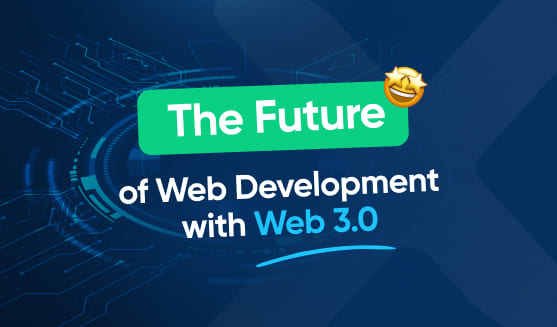
Web development has come a long way since the early days of the internet. With the rise of Web 2.0, websites became more interactive and user-centric. However, the next leap in web development is just around the corner – Web 3.0. In this article, we will explore what Web 3.0 is, its key features, its impact on web development, the challenges and opportunities it presents, and how developers can prepare for this exciting new era.
Understanding Web 3.0
Before delving into the intricacies of Web 3.0, it is important to have a clear definition of what this concept entails.
Web 3.0, often referred to as the Semantic Web, is an evolution of the internet where data is not only linked but also understood by machines. It aims to create a more intelligent and personalized web experience by utilizing artificial intelligence (AI), machine learning, and natural language processing.
Imagine a web where every piece of information is not just a string of characters, but a meaningful entity that machines can comprehend. Web 3.0 is like a digital brain that can process and interpret data, allowing for a more intuitive and efficient online experience.
Key Features of Web 3.0
Web 3.0 introduces several key features that distinguish it from its predecessor, Web 2.0.
- Decentralization: Web 3.0 leverages blockchain technology to create a decentralized and trustless environment. This enables more secure transactions and eliminates the need for intermediaries. Imagine a web where you can confidently engage in online transactions without worrying about the risk of fraud or data breaches.
- Interoperability: Web 3.0 enables seamless communication and data exchange between disparate platforms and applications. This breaks down silos and creates a more connected web ecosystem. It’s like having a universal translator that allows different systems to understand and collaborate with each other, fostering innovation and efficiency.
- Intelligence: With AI at its core, Web 3.0 can analyze and interpret vast amounts of data, enabling personalized recommendations and intuitive user experiences. Imagine a web that understands your preferences, anticipates your needs, and provides tailored content and services just for you.
- Privacy and Security: Web 3.0 prioritizes user privacy and data security, empowering individuals to have more control over their online identities and personal information. It’s like having a digital fortress that safeguards your data and ensures your online activities remain private.
How Web 3.0 Differs from Web 2.0
While Web 2.0 revolutionized the way we interact with the internet, Web 3.0 takes it a step further by focusing on data understanding and machine intelligence.
Web 2.0 was primarily about user-generated content, social networking, and interactive experiences. It brought us platforms like Facebook, Twitter, and YouTube, where users could create and share content with ease. However, Web 3.0 builds upon these foundations and adds advanced technologies like AI, blockchain, and the Internet of Things (IoT) to create a more intelligent and personalized web environment.
Imagine a web where your online experiences are not limited to static web pages or predefined interactions. Web 3.0 opens up a world of possibilities, where machines can understand and interpret data in real-time, allowing for dynamic and adaptive web experiences. It’s like having a personal assistant that knows your preferences, understands your context, and helps you navigate the vast digital landscape with ease.
The Impact of Web 3.0 on Web Development
Web 3.0 brings significant changes to the field of web development, revolutionizing the way developers code, create user interfaces, and employ artificial intelligence.
Web 3.0, often referred to as the Semantic Web, represents the next evolution of the internet, where information is not just linked but also understood by machines. This shift requires developers to think beyond traditional coding practices and embrace a more interconnected and intelligent web ecosystem.
Changes in Coding and Programming
With Web 3.0, developers need to adapt to new programming languages, frameworks, and tools. Smart contracts, written in languages like Solidity, become an integral part of decentralized applications (dApps) built on blockchain platforms. Additionally, developers will need to master new protocols and standards to harness the full potential of the Semantic Web.
Furthermore, the rise of Web 3.0 introduces the concept of decentralized autonomous organizations (DAOs), which are powered by smart contracts and operate without centralized control. This decentralized nature of Web 3.0 applications requires developers to implement robust security measures and ensure the integrity of their code to prevent vulnerabilities and exploits.
The Role of AI in Web 3.0 Development
As AI becomes more prevalent in Web 3.0, developers must embrace machine learning algorithms and natural language processing techniques. This allows them to unlock the power of intelligent automation, personalized recommendations, and conversational interfaces.
Moreover, the integration of AI in Web 3.0 extends beyond traditional web development tasks to include predictive analytics, content generation, and automated decision-making processes. Developers need to stay abreast of the latest advancements in AI technologies to deliver innovative and adaptive web solutions.
User Experience and Interface Design in Web 3.0
Web 3.0 opens up new avenues for enhancing user experiences and interface design. Developers must consider concepts like contextual awareness, adaptive interfaces, and multimodal interactions to cater to the evolving needs of users. Furthermore, creating intuitive and secure decentralized user interfaces presents unique challenges that developers must overcome.
In the realm of Web 3.0, user privacy and data ownership take center stage, prompting developers to design interfaces that prioritize transparency and user control over their personal information. This shift towards user-centric design requires a holistic approach that blends usability, accessibility, and data security to deliver seamless and trustworthy web experiences.
The Challenges and Opportunities of Web 3.0
While Web 3.0 holds immense potential, it also brings forth certain challenges that developers need to address.
As the digital landscape evolves with Web 3.0, developers are faced with the task of navigating through a myriad of security concerns. With decentralized platforms and smart contracts at the forefront, security becomes a critical concern in Web 3.0. To safeguard against potential threats, developers must implement robust encryption protocols, secure authentication mechanisms, and comprehensive auditing processes. By prioritizing security measures, developers can ensure the protection of user data and digital assets in this decentralized environment.
Security Concerns in Web 3.0
With decentralized platforms and smart contracts, security becomes a critical concern in Web 3.0. Developers must implement robust encryption, secure authentication mechanisms, and comprehensive auditing processes to protect user data and digital assets.
Furthermore, the evolution of Web 3.0 presents developers with the opportunity to enhance user experiences through greater interactivity. By leveraging technologies such as virtual and augmented reality, haptic feedback, and advanced graphics, developers can create immersive web experiences that captivate users. These advancements in technology enable the development of rich and engaging user interfaces and applications, setting the stage for a new era of interactive web experiences.
The Potential for Greater Interactivity
Web 3.0 paves the way for more interactive and immersive web experiences. Developers can leverage technologies like virtual and augmented reality, haptic feedback, and advanced graphics to create rich and engaging user interfaces and applications.
Moreover, Web 3.0 holds the promise of delivering personalized web experiences to users. By harnessing the power of user data, AI algorithms, and blockchain-based identity solutions, developers can offer tailored recommendations, customized interfaces, and personalized services to users. This level of personalization not only enhances user engagement but also fosters a deeper connection between users and the digital platforms they interact with, ultimately shaping a more user-centric web ecosystem.
The Promise of Personalized Web Experiences
Web 3.0 empowers users by delivering personalized experiences and content. Developers can leverage user data, AI algorithms, and blockchain-based identity solutions to provide tailored recommendations, customized interfaces, and personalized services.
Preparing for the Web 3.0 Era
As the future of web development unfolds with Web 3.0, developers must equip themselves with the necessary skills and adapt their practices to stay ahead of the curve.
Necessary Skills for Web 3.0 Developers
Developers should focus on mastering AI and machine learning technologies, blockchain development frameworks, and emerging protocol standards. By understanding the intricacies of AI and machine learning, developers can create intelligent web applications that can analyze user behavior, make personalized recommendations, and provide dynamic content. Moreover, proficiency in blockchain development frameworks will enable developers to build decentralized applications (DApps) that offer enhanced security, transparency, and immutability. Familiarity with emerging protocol standards, such as Solid and ActivityPub, will also be crucial for developers to ensure interoperability and seamless integration between different platforms and services.
However, it’s not just technical skills that will be essential for Web 3.0 developers. They must also possess strong problem-solving and critical-thinking abilities to navigate the challenges brought by the Semantic Web. The Semantic Web aims to make web content more meaningful and understandable to both humans and machines. Developers will need to design and implement semantic markup, ontologies, and knowledge graphs to enable intelligent data processing and facilitate efficient information retrieval.
Adapting Current Web Development Practices
Web developers can prepare for Web 3.0 by staying up-to-date with the latest advancements in the field. This involves exploring emerging technologies, attending conferences and workshops, and collaborating with experts in related domains. By actively engaging in the developer community, developers can gain valuable insights, exchange ideas, and stay informed about the latest trends and best practices.
Additionally, developers should actively contribute to open-source projects and engage in knowledge-sharing communities to foster innovation and keep pace with technological advancements. Open-source projects provide developers with opportunities to collaborate, experiment, and showcase their skills. By contributing to these projects, developers can not only enhance their own expertise but also contribute to the growth and evolution of the Web 3.0 ecosystem as a whole.
The Future Outlook for Web Developers
As Web 3.0 continues to evolve, the role of web developers will become even more vital. The demand for developers with expertise in AI, blockchain, and decentralized technologies will soar. Companies and organizations will seek developers who can leverage these technologies to create innovative solutions, improve user experiences, and drive business growth.
Web developers who embrace these emerging technologies and adapt their skills will be well-positioned to thrive in the Web 3.0 era. They will have the opportunity to shape the future of the web by designing and building intelligent, decentralized, and personalized applications that cater to the evolving needs and expectations of users.
In conclusion, Web 3.0 is poised to revolutionize web development by introducing decentralized, intelligent, and personalized experiences. The future of web development lies in the hands of developers who are willing to embrace new paradigms, acquire new skills, and adapt their practices. By harnessing the potential of Web 3.0, developers can shape the digital landscape and create innovative and transformative web experiences for users worldwide.


